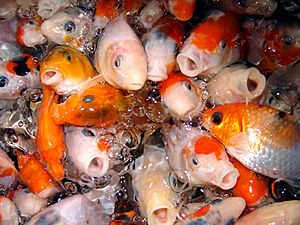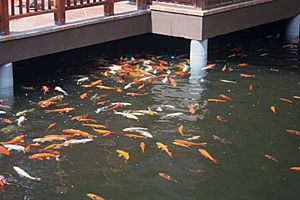Koi facts for kids
Quick facts for kids Nishikigoi |
|
|---|---|
 |
|
| Conservation status | |
| Scientific classification | |
| Kingdom: | |
| Phylum: | |
| Class: | |
| Order: | |
| Family: | |
| Genus: |
Cyprinus
|
| Species: | |
| Subspecies: |
C. c. haematopterus
|
| Trinomial name | |
| Cyprinus carpio haematopterus (Linnaeus, 1758)
|
|
Koi are beautiful, colorful fish. They are a special type of Amur carp. People keep koi as pets in outdoor koi ponds or water gardens.
There are many different kinds of koi. They are known for their unique colors, patterns, and scales. Some common colors are white, black, red, orange, yellow, blue, and cream. The most popular types of koi are called Gosanke. These include the Kohaku, Taisho Sanshoku, and Showa Sanshoku varieties.
New types of koi are still being created. For example, Ghost koi became popular in the 1980s. They have shiny, metallic scales. Butterfly koi, also called longfin koi, were also developed in the 1980s. They have long, flowing fins that look like wings.
Contents
The History of Koi
Carp are a large group of fish. They first lived in Central Europe and Asia. People in East Asia first tamed different carp species. They used them as food. Carp are coldwater fish. This means they can live in many different climates and water conditions. This helped them spread to new places, like Japan.
Over time, some carp were born with natural color changes. People in China started breeding carp for their colors over a thousand years ago. They used selective breeding to create the goldfish from the Prussian carp.
Keeping koi as a hobby spread all over the world. You can find them in many pet stores. Special dealers sell higher-quality fish. Many people enjoy collecting koi and building ponds for them. It's also common for koi lovers to join clubs. Members share tips and help each other with their fish and ponds.
How to Care for Koi
Common carp are very tough fish, and koi are just as strong. However, their bright colors make them easy targets for predators. A white Kohaku koi, for example, stands out against a dark pond. Many animals hunt koi, including Herons, kingfishers, otters, raccoons, cats, foxes, badgers, and hedgehogs.
A good outdoor pond has deep areas where herons can't stand. It also has edges that mammals can't reach. Shade trees can hide the pond from birds flying overhead. Sometimes, people put nets or wires above the water for extra protection. A pond usually needs a pump and filtration system. This keeps the water clean and clear.
Koi eat both plants and animals. They enjoy many foods, like peas, lettuce, and watermelon. Koi food is made to be healthy and float on the water. This encourages the fish to come to the surface to eat. When they eat at the surface, you can check them for any problems like parasites. Naturally, koi eat from the bottom of the pond. Some koi prefer this, so food makers also create sinking food. Koi learn to recognize the people who feed them. They will gather around at feeding times. You can even train them to eat food right from your hand!
Some koi have lived for a very long time. There are reports of them living 100 to 200 years. One famous red koi named "Hanako" was owned by several people. In 1974, scientists studied her scales. They found that Hanako was 226 years old!
Koi in the Wild
Koi have been released into the wild on almost every continent. This happens by accident or on purpose. When in the wild, they quickly lose their bright colors. They go back to looking like regular common carp within a few generations. In many places, they are seen as an invasive species or pests. For example, in Queensland, Australia, they are considered harmful fish.
Koi can make water very cloudy. They constantly stir up the mud at the bottom. This makes rivers and lakes look bad. It also reduces water plants and can make the water unsafe for swimming or drinking. In some countries, koi have caused so much damage. A lot of money has been spent trying to get rid of them, but it's been very hard.
In parts of North America, koi are sometimes put into golf course ponds. They help control insect larvae that live in the water.
Koi in Culture
The koi fish is very important in Japanese culture. It is a symbol of luck, wealth, and good fortune. Koi are closely linked to Japan's national identity.
In Sri Lanka, many homes have fish ponds in their courtyards. These ponds often have koi fish. Sri Lanka is one of the top countries for raising ornamental fish.
Images for kids
-
The Ojiya no Sato Museum in Niigata Prefecture, Japan. It's the only museum that shows living koi and their breeding history.
-
Different colored koi eating in a pond in Qingxiu Mountain, Nanning, China
See also
 In Spanish: Koi para niños
In Spanish: Koi para niños


















